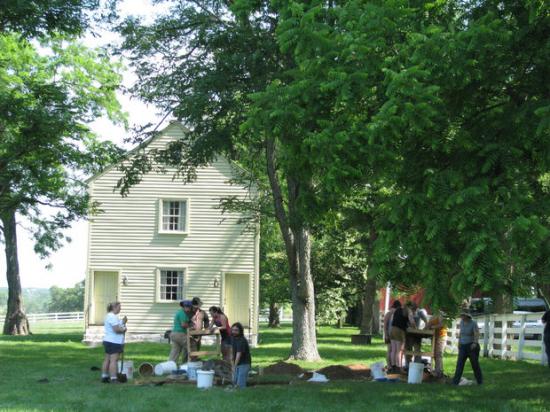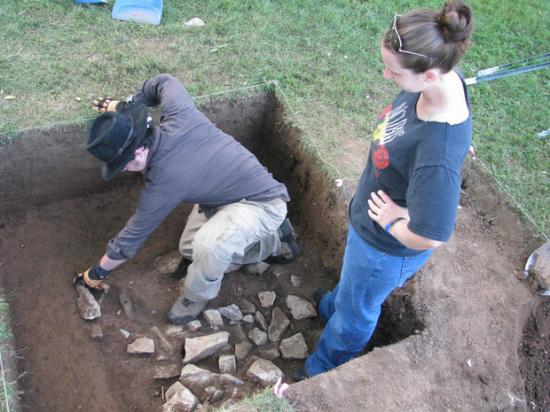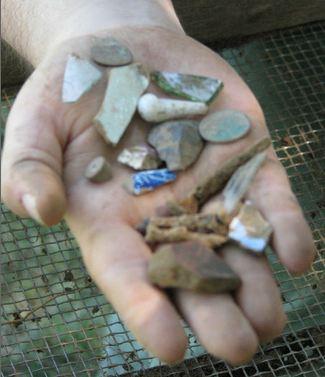Shakers' work amazes UK students digging into the past at Pleasant Hill
Greg Kocher / Photos: Greg Kocher
Source - http://www.kentucky.com/2012/05/27/2203284/shakers-work-amazes-uk-students.html
 University of Kentucky archaeology are taking part in a dig at the 1810 Meeting House at Shaker Village of Pleasant Hill in Mercer County. They started working May 8; their last day at the site will be June 15. — Greg Kocher | Staff
University of Kentucky archaeology are taking part in a dig at the 1810 Meeting House at Shaker Village of Pleasant Hill in Mercer County. They started working May 8; their last day at the site will be June 15. — Greg Kocher | Staff
The Shakers, the religious sect that lived in Mercer County from 1805 to 1910, were known for their frugality, industriousness and order.
All that is readily apparent in the buildings preserved at Shaker Village of Pleasant Hill, the nation's largest restored Shaker community.
But it turns out the Shakers were orderly in ways unseen until some University of Kentucky archaeology students excavated sites in the village.
X

Take, for example, the spot where the 1810 Meeting House stood before it burned in 1839. Two pits dug at the site reveal jagged pieces of rock, but not the squared, cut stones one might associate with a foundation.
"We think the Shakers, being very frugal, came in and dug up that foundation and reused it somewhere else," said Kim McBride, a UK anthropology professor and co-director of the Kentucky Archaeological Survey.
This long-gone structure and another, the Centre Family Dwelling, built in the 1810s but destroyed by fire in 1932, exhibit the same sense of symmetry and order that came to be Shaker characteristics.
"If you look at these buildings, including the little privy (near the 1812 Old Ministry's Shop), they're all on an exact line," McBride said. "A lot of visitors in the 19th century commented on how neat and orderly the Shakers were."
Work and craftsmanship were an expression of worship for the Shakers. That sense of orderliness comes across to students like Erica Osborne of Prestonsburg.
Standing on the edge of the Centre Family Dwelling's limestone foundation uncovered by the class, Osborne said she was amazed by the Shakers.

"We learn the hard work that they put into it," Osborne said. "The organization in their measurements — everything is so precise. In their minds, everything had to be so perfect."
The 14 students began their field work at Shaker Village on May 8. During their time there, they are learning the fundamentals of excavation, site interpretation ,and how to classify and catalog artifacts. They have found pieces of glass, brick, a chain link, buttons punched out from animal bone, and shards of Staffordshire earthenware imported from England.
On Thursday they found a chip of redware, a kind of domestic earthenware from the 1800s.
"You can tell where it has a glaze on one side where it's shiny," said field assistant Rebecca Knight.
The spot above the Kentucky River Palisades apparently was popular for humans long before the Shakers arrived in the 1800s.
"This Meeting House site is the only location on the Pleasant Hill property where we have located prehistoric Native American pottery, so that suggests a very intensive camp site or even a small village," McBride said. "So this was a special place for the Native Americans, too."
McBride's own history with Pleasant Hill dates to the 1990s. She and UK architecture professor Philippe Chavance found the Holy Sinai Plain, a secret outdoor worship site for the Shakers, in 1997.
McBride also conducted excavations inside the village's West Lot Wash House, where she found remnants of a system to bring spring water by gravity into the house to wash clothes.
For the students, digging in the dirt for pieces of history is another way to preserve history at Pleasant Hill, which marked 50 years of restoration work last year.

Jordan Whitaker of Hazard said the day and a half spent uncovering the Centre Family Dwelling's limestone foundation "felt like five minutes, but we were here for hours."
"This is always what I've wanted to do, to dig dirt and get my hands dirty and get a shovel in my hand," Whitaker said. "I love every minute of it."
Even the painstaking work of sifting through soil to find artifacts is rewarding for Morgan Beyer of Paducah.
"I think it's really fun to look through the dirt and try to find things," Beyer said. "It's sort of monotony, but it's the good kind of monotony. Not the boring kind."